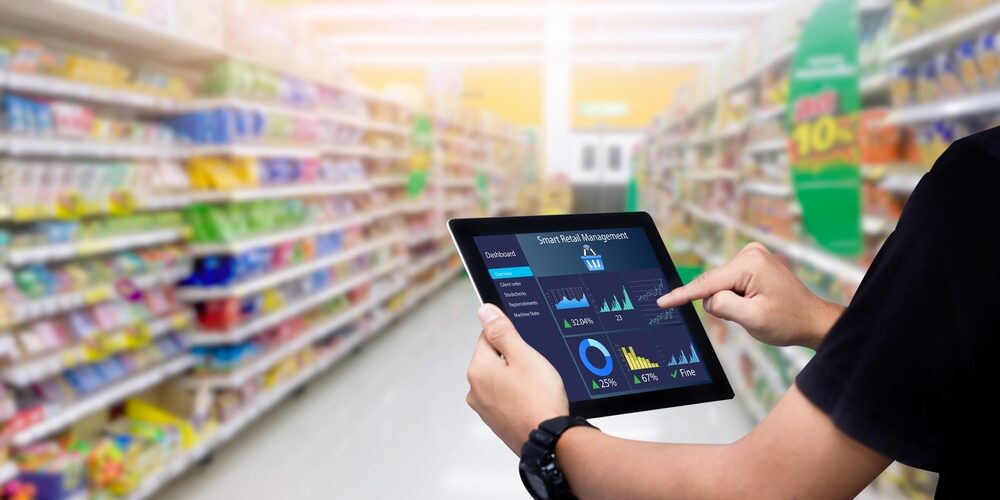
A Guide to Merchandising Software
As businesses navigate the dynamic interplay of e-commerce, brick-and-mortar stores, and omnichannel strategies, a crucial player has emerged: merchandising software. This critical retail execution software is used to drive a variety of tasks, including tracking inventory, managing products, setting prices and implementing promotions.
Understanding Merchandising Software
Merchandising software has become an indispensable tool in today’s high-speed retail environment. Businesses are constantly seeking ways to optimize their operations, improve efficiency, and increase sales.
Merchandising software meets the goals by supporting inventory management, order management, demand planning, promotional strategies, and much more. With advanced retail merchandising software, companies can make strategic decisions based on real-time analytics, enhancing supply chain management and ensuring customer satisfaction.
Definition and Purpose of Merchandising Software
Merchandising software is a digital solution designed to assist in the tasks and operations connected to retail merchandising. It facilitates demand planning, inventory management, order management, and more. Whether it’s building materials for a construction company, sporting goods for a fitness store, or flowers for a florist, the software allows for detailed merchandise planning.
Modern platforms bring together POS system capabilities with dynamic pricing and advanced inventory management. As we advance further into the digital age, merchandising software is becoming an integral part of midsize businesses and retail leaders alike.
The Importance of Merchandising Software for Business Efficiency
Retail merchandising software can enhance store execution, enabling retail managers and leaders to monitor and boost performance, ensure display compliance, and gain valuable information through insights dashboards. This combination of enhanced visibility and control is game-changing when it comes to improving a business’s bottom line.
Tools like image recognition available with merchandising system software help keep track of shelf space and product placement, allowing retail services to optimize promotion execution. Also, the retail execution software facilitates seamless interaction between retail leaders and the field team, improving communication, task delegation, and, ultimately, store performance.
Additionally, merchandising systems like planogram software are now equipped with advanced features such as price management, register management, and revenue management. These e-commerce tools are transformative for retail merchandising, allowing businesses to build personalized customer experiences and innovative pricing strategies.
Key Features of Quality Merchandising Software
Quality merchandising software has been a game-changer in the retail landscape, offering an array of features that boost efficiency and profits. As an integral part of supply chain management, choosing the right merchandising software requires a critical examination of features and benefits.
These software solutions are designed with a wide range of features, such as price management capabilities, image recognition components, and insights dashboards to aid in retail execution. While each software vendor offers unique advantages, commonalities exist in quality merchandising software, such as inventory management, product management, pricing, and promotional tools.
Understanding the key features of a software platform will help you select a solution designed to meet the needs of your retail operations — this is important in retail merchandising. Now, let’s dive into some of the features you’re likely to find, take a look at why the crucial, examine their variations, and get some tips from retail leaders.
Inventory Management
A key aspect of retail merchandising software is inventory management. This involves tracking inventory levels, orders, sales, and deliveries. This is vital for avoiding stock outs and surpluses, which can cripple business operations.
Quality software should aid in monitoring available stock and pending deliveries, further assisting in demand planning. It should also offer features such as retail outlook reports and field team management capabilities that help manage orders and detect discrepancies.
Important tips in selecting an excellent inventory management system include ease of integration, user-friendly interfaces, scalability, and real-time tracking abilities.
Product Management
Retail merchandising software isn’t just about inventory. It’s also about effective product management. This involves the control, selling, and reporting of products. Sporting goods companies, for instance, can leverage field team management software to manage a wide array of SKUs seamlessly.
A good software solution should offer easy product addition, images, detailed product descriptions, categorization, and search capabilities. These features allow for easy store execution and efficient resource management.
Pricing and Promotion Tools
Relevant tools for dynamic pricing and promotion execution are of the utmost importance in a merchandising software selection process. Among some of the most relevant features are price management, revenue management, and register management tools.
Pricing tools allow for setting up flexible, time-bound promotions, discounts, and offers. This helps in managing profit margins while boosting sales. Promotion tools leverage customer data to target relevant users with personalized offers.
How to Choose the Right Merchandising Software
Identifying Your Business Needs
Identifying your business needs is a crucial step when selecting the right software solution. Whether you’re a small retailer offering specific goods or a midsize business with diverse offerings, or one of the nation’s retail leaders, understanding your unique requirements is essential.
Consider factors such as the volume of your inventory, the extent of your retail services, the size of your field team, and your demand planning objectives.
By clearly defining your business needs, you can pinpoint a software solution designed to optimize your operations and provide tailored solutions that contribute to the efficiency and success of your retail services.
Comparing Different Merchandising Software Solutions
Once you have a clear picture of your business needs, the next step involves comparing different merchandising software. You might consider one option for its effective price management or another for its comprehensive omnichannel OMS capabilities.
You can evaluate the various aspects of merchandising software solutions, from performance management capabilities to e-commerce tools and insights dashboards to store execution features.
Additionally, keep in mind to check whether these systems offer resource center support. Powerful tools like planogram software for display compliance and image recognition technology for promotion execution can robustly optimize your retail operations.
Evaluating the Software Vendors
Finally, it’s essential to vet software vendors before investing in their merchandising system software. Check if vendors offer essential features like software selection assistance and tech advisor consultations.
By evaluating software vendors, you can ensure a hassle-free selection project and future-proof your retail business. From offering register management support to leveraging revenue management techniques, the right vendor can guide you in choosing the right merchandising system for your needs.








